Dominique Luchart's Blog, page 665
March 30, 2021
Watch live today: Virgin Galactic unveiling new ‘SpaceShipThree’ space plane @ 7:30 am ET, ,
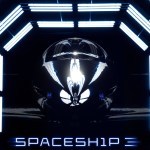
Richard Branson’s private space tourism company Virgin Galactic will unveil its newest space plane, called “SpaceShipThree” (or SpaceShip III) in a live webcast Tuesday (March 30) beginning at 7:30 a.m. EDT (1130 GMT). You can watch it live in the window above, courtesy of Virgin Galactic, or directly via the company’s YouTube.
Related: Virgin Galactic delays SpaceShipTwo test flights, pushing tourist flights to 2022
See more
Find out what the astronauts and cosmonauts aboard the International Space Station are up to by tuning in to the “ISS Live” broadcast. Hear conversations between the crew and mission controllers on Earth and watch them work inside the U.S. segment of the orbiting laboratory. When the crew is off duty, you can enjoy live views of Earth from Space. You can watch and listen in the window below, courtesy of NASA.
“Live video from the International Space Station includes internal views when the crew is on-duty and Earth views at other times. The video is accompanied by audio of conversations between the crew and Mission Control. This video is only available when the space station is in contact with the ground. During ‘loss of signal’ periods, viewers will see a blue screen.
“Since the station orbits the Earth once every 90 minutes, it experiences a sunrise or a sunset about every 45 minutes. When the station is in darkness, external camera video may appear black, but can sometimes provide spectacular views of lightning or city lights below.”
Follow us on Twitter @Spacedotcom and on Facebook.
Join our Space Forums to keep talking space on the latest missions, night sky and more! And if you have a news tip, correction or comment, let us know at: community@space.com.
The post Watch live today: Virgin Galactic unveiling new ‘SpaceShipThree’ space plane @ 7:30 am ET, , appeared first on NEWDAWN Blog.
Polaris and Optimus Ride are co-developing ‘fully autonomous’ low-speed shuttles,
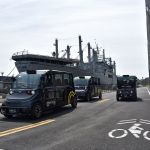
Autonomous shuttle startup Optimus Ride and power sports vehicle manufacturer Polaris are teaming up to co-develop a new lineup of vehicles that will be low-speed, electric, and self-driving.
These low-speed vehicles (LSV) will be equipped with Optimus Ride’s full stack of sensors and software to enable “fully autonomous” driving without a safety driver behind the wheel — though the vehicles will also be monitored remotely by a team of engineers who can offer suggestions to the vehicle when things go wrong.
The vehicles, which can seat six, will be deployed as a last-mile transportation service in residential communities, corporate and academic campuses, and other “localized environments,” as both a fixed-route shuttle and a more dynamic, point-to-point ride-hailing service.
The LSVs will be manufactured under the brand name GEM, which stands for Global Electric Motorcars. Minnesota-based Polaris owns GEM, having acquired it in 2011, and it’s also an investor in Optimus Ride. The startup, which originally spun out of the Massachusetts Institute of Technology, currently uses GEM shuttles to test its autonomous technology in Brooklyn, Boston, California, Washington, DC, and Northern Virginia.
The vehicles, which will be rolled out in the first half of 2023, will be built without traditional controls like steering wheels and pedals, said Optimus Ride CEO Sean Harrington — although there will still be a way to move the vehicles manually. “The intention is we would have all six seats available for passengers,” Harrington told The Verge, “which means where you have currently have a driver’s seat, would be another passenger seat.”
Harrington said the decision to co-develop vehicles with Polaris was about making a better autonomous vehicle and also scaling up production to the point where the startup can start to deploy potentially thousands of vehicles.
“There’s just a lot more flexibility you have by custom-designing that vehicle with safety and performance built in from the ground up, as opposed to doing it sort of piecemeal,” he said.
 Photo by Andrew Hawkins / The Verge
Photo by Andrew Hawkins / The VergeA dozen or so low-speed autonomous shuttle services have sprung up around the country in recent years. Experts see them as a good entry point for consumers into AV technology, while regulators and city officials like keeping the vehicles contained in small, less populated areas. Optimus Ride claims that it has completed “over 75,000 rides” over the last two years.
Optimus Ride isn’t the only company staking out a position in the low-speed autonomous shuttle space. Other companies, like May Mobility, Voyage (now owned by Cruise), and Local Motors, have launched small pilot projects in cities over the years — though they have yet to scale up to a fully operational commercial service.
Other AV operators, like Waymo, Zoox, and Cruise, are also interested in launching fully autonomous ride-hail operations. Harrington says that Optimus Ride can still be competitive with those companies, despite operating vehicles with a top speed of only 25 mph.
“To be clear, this is not some sort of virtual rails AV system where you get in an environment and if there’s an obstacle, if there’s something in your way, that vehicle can’t proceed,” he said. “This is a vehicle that is out in a fairly complex environment.” These limitations, Harrington said, position Optimus Ride to provide an autonomous transportation service “today, as opposed to many, many years from now.”
This kind of small-scale business can also be extremely difficult to get right. Drive.ai nearly went out of business before it got bought by Apple. And Navya, a major autonomous shuttle manufacturer based in France, is pivoting away from the shuttle business in favor of licensing its software to third-party clients.
Polaris makes a variety of off-road vehicles, including the popular RZR lineup as well as garish three-wheelers like the Slingshot. It also owns Indian Motorcycle, which it acquired in 2011. The company recently announced a partnership with Zero Motorcycle to co-develop electric vehicles, including ATVs and snowmobiles.
“I think this is the smart place for all of us to be betting on,” said Keith Simon, vice president and general manager of Polaris Commercial, “which is why we’re doing this and why we’re so excited about it.”
The post Polaris and Optimus Ride are co-developing ‘fully autonomous’ low-speed shuttles, appeared first on NEWDAWN Blog.
PayPal will let US users pay with Bitcoin, Ethereum and Litecoin starting today,

We already knew that PayPal was planning to support cryptocurrencies as a form of payment. And now, the online payment app announced US customers can do just that with its “Checkout with Crypto” feature, rolling out today.
After rolling out the ability for US users to directly buy and sell cryptocurrency directly from their accounts last November, PayPal’s new “Checkout with Crypto” allows users to instantly convert their Bitcoin, Ethereum, Litecoin, or Bitcoin Cash to US dollars (with no additional transaction fees) that PayPal then uses to complete the transaction. If a merchant doesn’t take US dollars, PayPal also converts those dollars into local currency at standard conversion rates set by PayPal.
 PayPal will support several types of cryptocurrency, including Ethereum and Bitcoin.
PayPal will support several types of cryptocurrency, including Ethereum and Bitcoin.The feature will automatically appear in the PayPal wallet if a user has a “sufficient cryptocurrency balance to cover an eligible purchase,” and you’ll be able to see your crypto balances for each kind of coin in the app. However, you can only use one type of cryptocurrency for each purchase you make.
PayPal is not the first payment app to offer support for cryptocurrency. In 2018, its competitor, Square, launched support for Bitcoin on the Cash App. But the launch of cryptocurrency as a form of payment makes PayPal both a major digital wallet and a cryptocurrency exchange, which could streamline the use of cryptocurrency as a more common payment method. During its Investor Day last week, the company reported that it had 377 million active accounts.
The post PayPal will let US users pay with Bitcoin, Ethereum and Litecoin starting today, appeared first on NEWDAWN Blog.
The LF-Z concept shows just how far Lexus has to go in EVs,

 Images: Lexus
Images: LexusToyota is finally following the rest of its peers into making all-electric vehicles, and that now includes its luxury brand, Lexus. On Tuesday, the Japanese marque revealed the LF-Z Electrified concept car, which is all about charting the company’s course into an electric future.
Mind you, that future in Lexus’ eyes still involves a healthy mix of hybrid and even hydrogen-powered vehicles, as well as gas-only cars. The company said Tuesday it will introduce 20 new vehicles by 2025 and that just 10 of those will be all-electric, hybrid, or run on hydrogen.
Lexus did say it wants to reach carbon neutrality “throughout the lifecycle of its entire model lineup” but that its goal is to do this by 2050. Lexus also acknowledged Tuesday that the industry is entering a period of “once-in-a-century” transformation, which is… something, considering that Toyota chairman Akio Toyoda recently bucked the trend and said electric vehicles are “overhyped.”
But back to the concept car. It’s angular and futuristic, like many concepts tend to be. It’s shorter than most modern Lexus vehicles, and even features a sort of inversion of the company’s iconic (for better or worse) massive grille; instead of a gridded black diamond pattern, the flat silver bodywork traces a triangular shape down the nose. Tracking with the design that many modern EVs have adopted, the rear of the LF-Z features a continuous light bar that’s broken up only by the company’s reimagined wordmark. And there’s a panoramic glass roof stretching across the top of the vehicle.
The interior is more radical, even if it is familiar to anyone who’s looked at a lot of concept cars. The bucket seats have a distinct geometric look to them, and are surrounded by various lighting elements. It’s otherwise quite sparse, save for the cluster of screens that hug the steering wheel.
Being a concept car, the LZ-F is less about specs and more about ideas and what Lexus imagines it might do with its future vehicles. One idea Lexus is chewing on with this concept is something called “Direct4,” which is basically just a branded version of torque vectoring that would drive power to each wheel independently, improving grip in high-performance situations. At a more base level, Lexus says this concept car is designed to achieve “ideal balance and inertia” while driving thanks to optimal placement of the battery and motors.
(This all sounds sort of like Nissan’s new torque vectoring system that is coming to the Ariya EV, though it’s hard to say for sure without more details.)

Also, Lexus says the driver’s position and the screens were designed based on “the new concept of ‘Tazuna'” — which is Japanese for “rein.” The company describes this part of the concept car as such:
Inspired by the relationship between horse and rider, who communicate through a single rein, steering wheel-mounted switches and the vehicle’s head-up display have been highly coordinated to create a space in which various functions, such as the navigation system, audio system, and driving mode selection, can be performed while concentrating on driving and without movement of the driver’s line of sight or need to operate complicated switches.
This wouldn’t be a true concept car without some kind of artificial intelligence, and so of course Lexus has accounted for that here. But the company says AI would be used in the LZ-F in frankly pedestrian ways, like predicting what route a driver might take, or making restaurant reservations. Lexus believes this is a big step forward, though. “Such interactivity between AI and driver leads to a fruitful dialogue, thus improving the overall ownership and driving experience, adding color to the customer’s life as a lifestyle concierge,” the company writes.
There are a few other more grounded technological features, like a digital key that allows multiple people to access the car, or door handles that present themselves — both the kinds of things that are already increasingly common on modern electric vehicles. It, of course, has autonomous driving modes.
In fact, the more you look at the LZ-F, the more you may realize that it’s as much of a sign of what Lexus (and Toyota) have missed out on as it waited to chart this bold vision of the future of the brand — even if it is a far more realistic take than the drone-deploying LF-30 EV concept Lexus showed off in 2019.
The company has played a very conservative hand here at the beginning of what is, by its own admission, a massive transformation in the industry. And while there are certain advantages to that strategy — like not spending dozens of billions of dollars — the LZ-F is a good reminder of some of the disadvantages, too.
Lexus surely thinks it can do some of these things better than the rest of the competition no matter when it brings some of the LZ-F’s ideas to market. But if the future really is electric, Lexus will still find itself playing catch-up for the foreseeable future. The LZ-F is proof.
The post The LF-Z concept shows just how far Lexus has to go in EVs, appeared first on NEWDAWN Blog.
Google is making some big upgrades to directions in Google Maps,
Google is announcing a bunch of new features planned for Google Maps, including a new tool to help with indoor navigation and suggestions for eco-friendly driving routes. The features announced today aren’t rolling out all at once, though; many aren’t available just yet, and it’s unclear when some will be available in some parts of the world.
One of the biggest announcements is that Google is bringing its Live View augmented reality directions to airports, transit stations, and malls. Live View directions let you hold your phone up, point your camera at the world around you, and see arrows and icons pointing you where you need to go, and previously, they only worked outdoors.
Disappointingly, though, these indoor AR directions aren’t being rolled out very widely yet: they’re only available in some malls in Chicago, Long Island, Los Angeles, Newark, San Francisco, San Jose, and Seattle right now. Google will launch indoor Live View directions in select transit stations, airports, and malls in Tokyo and Zurich in the coming months, however, and more cities are “on the way,” the company says.
[image error]
Google is also planning to revamp the interface for picking your mode of transportation for directions on Android and iOS. Right now, you have to toggle through different tabs to see more detail about different transportation options, but with this new interface, you’ll just scroll through a list. The company says Maps will even be able to prioritize the modes you prefer and put those that are popular in certain cities (the subway in New York City, for example) higher up the list. This new interface is set to roll out globally in the coming months.
[image error]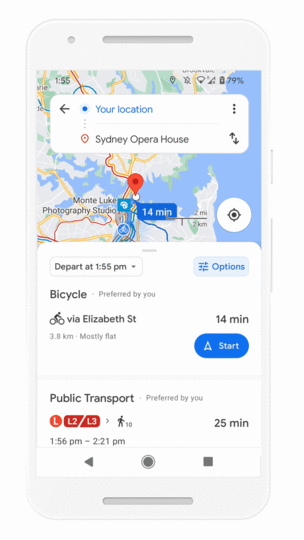
In addition to the directions interface, Google is adding a new type of driving route that’s optimized for lower fuel consumption. If the eco-friendly route has about the same ETA as the fastest route to a location, Google Maps will default to the fuel-efficient route, though you can change this in settings if you’d like. Google plans to make these new fuel-efficient routes available on Android and iOS in the US later this year and globally at an unspecified time in the future.
[image error]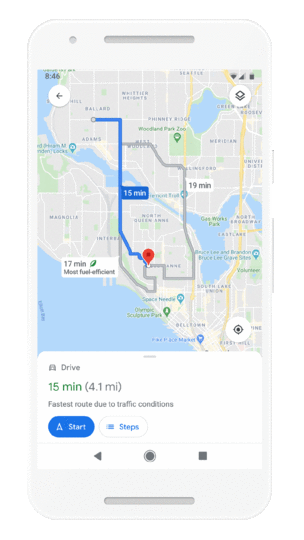
The fuel-efficient routes aren’t the only eco-friendly updates for Maps: Google also plans to introduce alerts that will tell you when you’ll be navigating through low-emissions zones, which don’t allow some vehicles with certain levels of emissions to enter. Google says these alerts will launch in France, Germany, the Netherlands, Spain, and the UK on Android and iOS this June. More countries will get the alerts soon, according to Google.
 Image: Google Maps
Image: Google MapsGoogle is also making new map layers for weather and air quality that are set to roll out in the coming months on Android and iOS. Google plans to launch the weather layer globally and launch the air quality layer first in Australia, India, and the US.
 Image: Google
Image: GoogleGoogle also plans to pilot a new grocery pickup tool this summer with select Portland, Oregon-based locations of Kroger-owned grocery store Fred Meyer. The tool lets you share your location and ETA with the store via Google Maps so that your grocery order can be ready when you arrive.
The post Google is making some big upgrades to directions in Google Maps, appeared first on NEWDAWN Blog.
March 29, 2021
NASA wants to help private space stations get off the ground, ,
NASA is taking more steps to support new commercial space stations in low Earth orbit (LEO).
NASA held an online industry briefing about”commercial LEO destinations” Tuesday (March 23) to solicit feedback on its plan to date, as the agency thinks about its next crewed exploration steps in near-Earth space.
With the International Space Station (ISS) expected to retire as early as 2024 — or possibly in 2028, if the multinational partners agree — NASA wants to involve industry in a new generation of space stations. NASA is also considering having the ISS partners participate in a new commercial space station, although such negotiations are at an early stage given how novel the idea is.
Related: How the International Space Station will die
“ISS is an amazing system, but unfortunately it won’t last forever; it could experience an unrecoverable anomaly at any time,” Phil McAlister, director of commercial spaceflight development at NASA headquarters, said in Tuesday’s briefing.
“Pretty much any space initiative can take a while, and longer than you might hope, so we really do feel like the time to get started is now, when the ISS is still in good health and providing good capability across the board,” he said.
The agency’s newly announced Commercial LEO Development program is expected to release the first draft announcement of proposals in April, with a final version following in May. The plan is to bring the proposed commercial space stations to the preliminary design review stage by the end of fiscal year 2025 — and for NASA to discuss potential customers and destinations for the orbiting facilities. (Fiscal year 2025 runs from Oct. 1, 2024 through Sept. 30, 2025.)
“The way we see the transition [from ISS] is, we’re not going to just turn off the lights one day,” McAlister said. “We’re going to have an overlap period where we, over a period of time, draw down the operations of ISS as we increase operations for LEO destinations. So that gives us some time.”
Bringing in private sector partners now will allow them to have “skin in the game” at this early stage, he added, especially with the incentive that they can retain their own intellectual property for other ventures.
The program will start with two to four funded Space Act Agreements, which allow NASA to work with external entities on agency priorities. The agreements, expected to have a combined value of between $300 million and $400 million, should be awarded in the fourth quarter of 2021 to fund work starting in fiscal year 2022, which will be completed in fiscal year 2025.
Related: NASA wants to encourage private space stations
“We are doing our best to communicate our plans to our stakeholders in Congress and the administration, and we’re hopeful that budget requests will be funded,” McAlister said. The money the program requires can still be awarded in “various budget realities,” although if NASA does not get its desired budget request for several fiscal years, “that does increase the risk of a gap,” he added.
Angela Hart, manager of the commercial LEO development program office at NASA’s Johnson Space Center in Houston, said that using Space Act Agreements for the new commercial LEO initiative “does provide us with some flexibility” in case of uncertainty on the NASA budget side.
Such agreements have fewer obligations than other contract vehicles, and this flexibility may be a necessity under NASA’s budgetary realities when it comes to ISS successors. NASA had requested $150 million for commercial LEO development in both fiscal years 2020 and 2021 but only received $15 million and $17 million, respectively. The 2022 budget proposal will likely be made public in May.
If all goes according to plan, NASA plans a second phase of the commercial LEO program in 2026 to certify commercial station activities and to figure out access for astronauts and payloads. But that is still in preliminary planning, NASA officials cautioned in the briefing, especially as the agency figures out how such activities would relate to ongoing ISS operations.
While NASA would likely be the “anchor tenant” in a new commercial facility, Hart pointed to a need to expand economic opportunities for other space players. “We want to continue to lay the groundwork for a market environment where, commercially, services will be available to both government and private sector customers,” she added.
NASA expects that, after the ISS program concludes, the agency will want to have at least two crewmembers in Earth orbit most, if not all, of the time. That would be a slight decrease from the typical current maximum of three people on the U.S. side of the space station. These astronauts would continuously perform at least 200 science or research focused investigations a year — bearing in mind that other astronauts might be occupied on the moon as part of NASA’s Artemis program, which is expected to ramp up later in the 2020s.
McAlister said he hopes that transportation costs to orbit will come down under the new model. “We have to transport those crews to the International Space Station, and we have to keep them supplied with food and water and all the necessary supplies,” he said of the current situation.
“Going forward,” he added, “commercial destinations that are focused on the actual demand for NASA will necessarily be smaller … If there is sufficient demand for something that is the size and capability of the ISS, we would expect the private sector to address that through their means.”
NASA has already pivoted ISS operations into a more commercial direction in recent years, including partnerships with companies to deliver cargo and astronauts on private spacecraft.
Related: SpaceX’s Crew-1 astronaut mission to the International Space Station in photos
For example, SpaceX has already launched two crewed ISS mission missions with its Crew Dragon capsule. Boeing also holds a NASA commercial crew contract but has been beset with delays in getting its Starliner capsule certified for human spaceflight.
The ISS will also welcome its first all-private crew in 2022, if schedules hold. That mission, which is being organized by the private company Axiom Space, will fly aboard Crew Dragon. “We’ve been getting a lot of press these days about our private astronaut missions,” McAlister said. “These are primarily tourism-based but also include outreach and commercial [research and development].”
In 2019, NASA issued a call for proposals to add commercial modules to the ISS or build separate commercial stations, dubbed “free flyers.” The solicitation was open enough to allow for a single new module or a set of modules, depending on the proposal.
NASA issued a solicitation for a docking port and selected Axiom Space in January 2020. However, that August, the agency said it would not have the “free-flyer” solicitation, without offering further details, according to Space News.
Hart spoke about the 2019 solicitation during Tuesday’s briefing, saying in her slides that the pivot to the docking port was “more appropriate due to the current budget allocations and immature design maturation affecting data deliverables.”
Follow Elizabeth Howell on Twitter @howellspace. Follow us on Twitter @Spacedotcom and on Facebook.
The post NASA wants to help private space stations get off the ground, , appeared first on NEWDAWN Blog.
NASA joins White House Climate Task Force, ,
NASA has joined the White House National Climate Task Force, another step in the agency’s continued study of climate change and global warming.
On Jan. 27, President Joe Biden issued an executive order that outlined the details of the National Climate Task Force. Last Thursday (March 18), NASA announced that it has joined the task force, which “shall facilitate the organization and deployment of a Government-wide approach to combat the climate crisis,” according to the executive order.
The new partnership follows a January announcement from NASA that 2020 was tied with 2016 as the hottest year on record.
“The United States and the world face a profound climate crisis. We have a narrow moment to pursue action at home and abroad in order to avoid the most catastrophic impacts of that crisis and to seize the opportunity that tackling climate change presents,” the executive order reads.
Related: 2020 ties record for the hottest year ever, NASA analysis shows
“Climate change is one of the most pressing issues facing us today,” Gavin Schmidt, acting NASA senior climate advisor and director of NASA’s Goddard Institute for Space Studies in New York, said in a NASA statement. “Given our unique ability to observe the planet from space and the long-term data records we’ve been able to assemble, NASA is in a prime position to inform policy decisions in the current administration and beyond.”
The Biden administration is focused on tackling climate issues and is putting the climate crisis “at the center of United States Foreign Policy and National Security,” according to the order. And it’s no surprise that NASA is joining the task force. The space agency has been involved in climate issues for decades, starting in 1960 when NASA launched TIROS-1 (the Television and Infrared Observation Satellite), the first weather satellite.
NASA also continuously updates its climate website with information about rising global temperature, carbon dioxide rates and Arctic ice loss, among other factors impacted by climate change.
Since the TIROS-1 launch, the agency has placed many Earth-monitoring satellites in orbit that have collected data about Earth’s changing climate. Right now, there are over two dozen NASA satellites circling Earth monitoring everything from soil moisture to carbon dioxide levels, according to the same NASA statement. You can learn more about NASA’s climate and Earth-monitoring missions here.
With its Earth-monitoring missions like Aqua and ECOSTRESS and “efforts to contribute to sustainable aviation and nurturing partnerships with the private sector, NASA already is poised to help the task force address the most pressing climate change issues today,” according to the statement.
Email Chelsea Gohd at cgohd@space.com or follow her on Twitter @chelsea_gohd. Follow us on Twitter @Spacedotcom and on Facebook.
Join our Space Forums to keep talking space on the latest missions, night sky and more! And if you have a news tip, correction or comment, let us know at: community@space.com.
The post NASA joins White House Climate Task Force, , appeared first on NEWDAWN Blog.
A mission to Uranus and Neptune could act as massive gravitational-wave detector, ,
Paul M. Sutter is an astrophysicist at SUNY Stony Brook and the Flatiron Institute, host of Ask a Spaceman and Space Radio, and author of How to Die in Space. He contributed this article to Space.com’s Expert Voices: Opinions and Insights.
What if one mission could study the gravitational waves triggered by some of the most violent events in the universe — on the way to observing the least-known planets of our solar system?
Planetary scientists are desperate for a new probes to Uranus and Neptune, since these ice giant worlds haven’t been visited since the Voyager mission flybys of the late 1980s. And while such a spacecraft would unearth a treasure trove of information about these solar system siblings, it could also peer much deeper into the universe, scientists say in a new analysis: By carefully monitoring variations in the radio signals from one or more such spacecraft, astronomers could potentially see the ripples in gravity caused by some of the most violent events in the universe.
Related: Voyager at 40: 40 Photos from NASA’s epic ‘grand tour’ mission
Ice, ice babyPoor Uranus and Neptune. The only close-up images we have of those outer worlds come to us from the Voyager 2 spacecraft, which swung by those planets on its “Grand Tour” in the late 1980s. Since then, we’ve sent probes to Mercury, missions to Jupiter and Saturn (including landing on the latter’s moon Titan), collected samples of asteroids and comets, and launched rover after rover to Mars.
But not Uranus or Neptune. Those worlds, now known as “ice giants” because water and ammonia ices dominate their composition, sit lonely in the outer fringes of our celestial neighborhood. There are no other worlds in the solar system quite like them, and an entire generation of planetary scientists have been able to study them with only ground-based telescopes and occasional glimpses from the Hubble Space Telescope.
Some of that delay has been out of our hands. Even Neptune at its closest sits over 2.7 billion miles (4.3 billion kilometers) away from the Earth.The extreme distance to Neptune and Uranus makes it incredibly hard to launch payloads there.
But an opportunity is coming soon, window during which Jupiter lines up just right to offer a much-needed velocity-boosting gravitational assist and cut travel time to the outer system. If we were to launch a mission in the early 2030s on a sufficiently powerful rocket, like NASA’s Space Launch System, a mission could reach Jupiter in a little less than two years for that speed boost. From there, a single spacecraft could separate into two components, one headed for Uranus (reaching it in 2042) and another for Neptune (achieving orbit a couple years after that).
Once in place, if luck prevails, those orbiters could maintain their station for over a decade, as the famed Cassini mission did at Saturn.
A shift to the leftDuring the long cruise to those icy destinations, those same space probes could also offer insight into a very different type of science, that of gravitational waves, as detailed in a paper recently uploaded to the preprint server arXiv.org and submitted to the Monthly Notices of the Royal Astronomical Society Letters.
During the course of the flight, scientists and technicians on the ground would constantly have to communicate with the spacecraft, updating its trajectory and checking its status. And conversely, the spacecraft would constantly radio back information to the Earth.
[image error]
An artist’s depiction of gravitational waves. (Image credit: R. Hurt/Caltech-JPL)Light waves bouncing back and forth along an extremely long path.
Sound familiar? On Earth, physicists reflect laser beams along miles-long tracks to measure passing gravitational waves. As the waves (which are ripples in the fabric of spacetime itself) pass through the Earth, they distort objects, compressing and stretching them in alternating series. Inside the detector, these waves subtly change the length between distant mirrors, affecting the path of light in the gravitational wave observatories by a minute amount (usually less than the width of an atom).
For radio communications from a distant space mission back to Earth, the effect is similar. If a gravitational wave passes through the solar system, it would change the distance to the spacecraft in a regular way, causing the probe to be ever-so-slightly closer to us, then farther away, then closer again. If the spacecraft was sending a transmission the entire cruise, we would see a resulting Doppler shift in the frequency of its radio communication. Having two such spacecraft acting at once would give astronomers sharper observations of that shift.
In other words, these far-flung space probes could do double-duty as the largest gravitational wave observatories in the world.
The greater universeThe biggest technological hurdle is the ability to measure the frequency of the spacecraft’s radio communications to an incredibly high precision. According to the recent research, our ability to measure this must be at least 100 times better than we could achieve for the Cassini mission to Saturn.
That sounds like a lot, but it’s been decades since Cassini was designed, and we’ve been improving our communication technologies the whole time. And physicists are currently designing their own space-based gravitational wave detectors, like the Laser Interferometer Space Antenna (LISA), which will require similar technology anyway. Since an ice giant mission is still almost a decade away, we could pour even more resources into developing the necessary technology.
If we can crack that level of sensitivity, then the extreme length of this gravitational wave detector “arm” (literally billions of times longer than our current detectors) could reveal a variety of extreme events in the universe. Due to its incredible length, this “ice giant observatory” would be sensitive to an entirely different class of events than what we can observe today. According to the research, during the lifespan of such a mission, the probes are likely to detect a few dozen mergers of black holes with extreme mass differences, and at least one merger of a supermassive black hole. These are events that we simply have not observed, and cannot observe, with current gravitational wave detectors.
Oh, and we would also get to learn about Uranus and Neptune.
Follow us on Twitter @Spacedotcom or Facebook.
The post A mission to Uranus and Neptune could act as massive gravitational-wave detector, , appeared first on NEWDAWN Blog.
A Jony Ive and Marc Newson-designed Leica prototype is headed to auction,

A rare prototype of a Leica camera crafted by former Apple luminary Jony Ive and famed designer Marc Newson is being sold at auction in June. The device, which is described as being in “B+” condition, has a starting price of EUR100.000 (around $118,000), and the Leitz Photographica Auction house estimates that it’ll sell for between EUR200.000 and EUR250.000 (around $235,000 to $295,000).
The prototype was produced during the development of the one-off Leica M for (RED) camera, which was sold at a charity auction in 2013 for $1.8 million. While the final product’s design shared a lot of similarities with Apple’s “cheesegrater” Mac Pro, this prototype appears to have a smooth reflective finish that looks like an absolute fingerprint magnet.
 The prototype has a reflective surface.Image: Leitz Photographica Auction
The prototype has a reflective surface.Image: Leitz Photographica Auction Condition is listed as “B+”Image: Leitz Photographica Auction
Condition is listed as “B+”Image: Leitz Photographica Auction The camera shows Ive’s trademark minimalist design.Image: Leitz Photographica Auction
The camera shows Ive’s trademark minimalist design.Image: Leitz Photographica Auction It’s equipped with a Apo-Summicron 2/50 mm ASPH lens.Image: Leitz Photographica Auction
It’s equipped with a Apo-Summicron 2/50 mm ASPH lens.Image: Leitz Photographica AuctionThe prototype, which is described as showing the “final development step” of the design process, is equipped with a Apo-Summicron 2/50 mm ASPH lens. There’s no mention of whether it actually functions as a camera, however. Here’s the full description from Leitz Photographica Auction:
“A beautifully sculptured aluminium body with a matching Apo-Summicron 2/50 mm ASPH. lens — both showing distinctive features both designers are famous for. Only one finished camera has been made and was sold in an auction in 2013 for an amazing $ 1.8 M! The prototype we have the pleasure to offer shows the final development step when the camera took its final shape after hundreds of prototype parts have been made and tried. It is a beautiful piece of design and a very special opportunity for Leica collectors!”
At the time, Leica said “a total of 561 models and nearly 1000 prototype parts” were made during the camera’s design process. The final Leica M for (RED) camera was sold alongside over 40 other items at the auction, which raised around $26 million in total for charity. Newson later joined Apple to work under Ive the following year.
The post A Jony Ive and Marc Newson-designed Leica prototype is headed to auction, appeared first on NEWDAWN Blog.
Boston Dynamics unveils Stretch: a new robot designed to move boxes in warehouses,
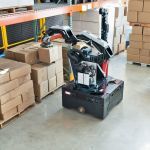
Boston Dynamics is best known for its robot dog Spot, a machine designed to work in a range of environments, from offshore oil rigs to deep underground mines. But in recent years, the company has increasingly focused attention on the logistics space, and today is unveiling a new robot with just one application in mind: moving boxes in warehouses.
The robot is called Stretch and looks relatively dull for a Boston Dynamics creation. It’s not modeled after humans or animals, and instead aims to be as practical as possible. It has a square mobile base containing a set of wheels, a “perception mast” with cameras and other sensors, and a huge robotic arm with seven degrees of freedom and a suction pad array on the end that can grab and move boxes up to 23 kilograms (50 lbs) in weight.
What connects Stretch to other Boston Dynamics machines is a focus on mobility. Usually, when automation equipment is installed in warehouses the system is bolted down in one place with a workflow modeled around it. Stretch, by comparison, is designed to slide into any existing workplace where it could be useful loading or unloading goods.
“That’s what’s exciting about this system: it can provide automation to environments that don’t have automation infrastructure,” Boston Dynamics’ VP of business development Michael Perry tells The Verge. “You can take this capability and you can move it into the back of the truck, you can move it into aisles, you can move it next to your conveyors. It all depends what the problem of the day is.”
 Stretch can run off batteries for eight hours at a time or switch to tethered power. Image: Boston Dynamics
Stretch can run off batteries for eight hours at a time or switch to tethered power. Image: Boston DynamicsThis will allow Boston Dynamics to target customers who would otherwise avoid automation as too expensive or time-consuming to integrate, says Perry. Around 80 percent of the world’s warehouses don’t have any automation equipment, giving the company a sizable addressable market. But Stretch doesn’t have a price-tag yet, and it could be that for businesses with low margins, a robot isn’t worth the hassle no matter how mobile it is.
Boston Dynamics has been showing interest in the logistics space since 2019 when it purchased Kinema Systems, a company that makes machine vision software for robots in warehouses. It then designed a wheeled robot called Handle that could move boxes using a robotic arm, balancing itself with a huge swinging counterweight like a tail.
Perry says Handle had “the right footprint and right reach” for warehouses, but couldn’t work fast enough. The robot’s arm is directly attached to its main body, meaning the whole machine had to move with each load. Stretch’s arm, by comparison, swivels freely thanks to some clever (and patent-pending) counterweights hidden inside its square base.
“That’s really the secret sauce,” says Perry. “That base is able to handle the inertial force of the arm plus the box swinging at a fast weight, without having to rely on a several-thousand kilo steel plate bolted to the floor.”
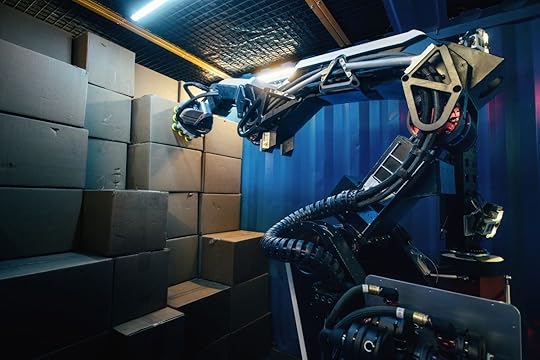 Stretch’s vacuum grippers mean it can only handle boxes with flat surfaces — limiting its usefulness in certain warehouses. Image: Boston Dynamics
Stretch’s vacuum grippers mean it can only handle boxes with flat surfaces — limiting its usefulness in certain warehouses. Image: Boston DynamicsStretch’s lineage can be traced back to Boston Dynamics’ two-legged Atlas robot, which is able to balance its weight so smoothly it can run, jump, backflip, and more. “Atlas picking up a box isn’t just about extending the arms and moving them, it’s about coordinating the hips, legs, and torso,” says Perry. “A lot of that same design thinking has gone into Stretch.”
As a result, Boston Dynamics claims Stretch can move up to 800 cases an hour, a through-put rate that’s comparable to that of a human employee. High-capacity batteries mean Stretch can operate for eight hours at a time before it needs recharging.
That throughput rate, though, should be treated with skepticism. Putting robots to work in warehouses is incredibly difficult because of the sheer variation in these spaces. Workflows can change on a daily basis as different goods come and go, and what’s often valued is flexibility. The inability of machines to handle these challenges so far is what’s led to an all-or-nothing dynamic in automation. You either remake the entire warehouse so it’s regular enough for machines to understand, or you stick with humans, masters of the unknown.
Boston Dynamics’ big claim is that Stretch will be able to bridge this divide. The company says the robot can be operated by anyone with just a few hours of training, and that its mobile base means it can slot into spaces designed for humans. Will it work? We’ll only find out once Stretch gets to grips with the job. Boston Dynamics says it’s currently looking for customers to pilot test Stretch, and is aiming for commercial deployment in 2022.
The post Boston Dynamics unveils Stretch: a new robot designed to move boxes in warehouses, appeared first on NEWDAWN Blog.



